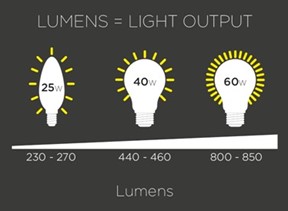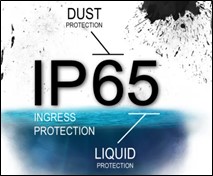What to look for while buying outdoor lights?
What to look for while buying outdoor lights?
Not all lights are made equal. That’s the reason we have measurements to understand and identify good quality lights. In this section we have attempted to explain some of the most important considerations that tops this list. We have explained how to read and understand these numbers specified on the packaging, to assist you to shortlist the lights most suitable for your needs.
Lumens (lm)
A lumen is a measure of the amount of brightness of a lightbulb - the higher the number of lumens, the brighter the lightbulb. In simpler words, more lumens means it's a brighter light; fewer lumens means it's a dimmer light. It is denoted by ‘lm’ next to the numeric value for the bulb.
So, compare lumens value to be sure you're getting the amount of light, or level of brightness, you desire and not the Wattage (W), as Watts is the measurement of Energy use and not the light output. For example, in the case of Decklights, a very bright light may cause discomfort. Hence choose the brightness and the optical angle of the deck light based on placement of your lights.

IP Rating
Ingress Protection (IP) rating value of an electrical product specifies its degree of protection against external environmental elements such as moisture, dust and vermin.
The first digit that ranges from 0-6 indicates the level of protection against the intrusion of foreign solid objects such as dust while the second digit that ranges between 0-8 indicates the level of protection against the ingress of water and moisture. When put together, the two numbers will determine the likelihood of any foreign object entering the light fitting and possibly damaging it.
A poorly manufactured cheap products can be harmful due to potential electrical faults. Having an IP rating that suits the application will help you eliminate unnecessary heartache to due to repeated product failures.
A light fitting that does not specify an IP rating value indicates that it is designed for indoor use (except shower area). Good quality high-end outdoor lights will have an IP rating of 65 and higher. Outdoor lights that are IP rated 65 or higher will be highly resistant to external elements and are perfectly suitable for areas that are exposed to heavy rain and strong coastal wind. Some of the common IP rating used for outdoor mechanical or electrical units are -
IP55 : Dust Proof, Jet Proof
IP64 : Dust Tight, Splash Proof
IP65 : Dust Tight, Jet Proof
IP67 : Dust Tight, Watertight
IP68 : Dust Tight, Pressure Watertight

Colour Temperature (K)
Light appearance, measured by correlated colour temperature (CCT) on the Kelvin (K) scale, in a scale of 1,000 to 10,000 from warm to cool.
- 2,700K – 3,200K : These bulbs produce soft white or warm white or yellowish coloured light. This one is best for places where you relax such as the bedroom, since this colour temperature gives a cozy feeling.
- 3,200K – 5,000K : LED bulbs with this rating produce a bright white or cool toned kind of colour which gives a warm effect as well as bright enough to work beneath it. It is mostly used in kitchens.
- 5,000K and above : These LED bulbs produces a bright daylight kind of colour. So, it’s good for bathrooms and your study.

Material of construction:
Outdoor lights are exposed to several environmental conditions, such as pollution, rainfall, salty air etc. Hence the choice of materials used to construct the light fittings plays an important role in this regard. Some of the well proven material used in good quality light fittings are detailed below.
Brass, Cooper & Bronze:
These metals are deemed as the most reliable and most long-lasting materials for outdoor settings. They demonstrate high corrosion & weather resistance and are used for coins for these reasons. Brass and Cooper also get darker over time which adds to the thematic and antic aged look. The colour (oxidation) also adds to its protection from rust and corrosion. They also work well with coastal properties that are exposed to salt environments too.
Aluminium:
It is one of the most popular material choices for lighting fixtures due to its light weight and malleable properties which makes it easy to cast into complex designs. Aluminium forms an oxide layer when in contact with air (oxygen) which prevents the metal from corrosion. This is further enhanced by an electrochemical process called anodization and further make it scratch resistant.
Steel:
Steel is also another most commonly used material for outdoor light fixtures as it effectively reflects light making it look very bright. Steel is prone to Tea staining, a natural surface discolouration process that does not affect the structural integrity of the material, but often mistook as rust. Hence the grade of the stainless steel used in the light fixture affects its rate of corrosion and longevity.
Stainless steel 304 and 316 are the two common grades of stainless steel used in the lighting industry. Although they look identical, 304 is the less expensive variant but less corrosion resistant than the 316 grade.
Colour Rendering Index (CRI)
Colour Rendering Index (CRI) is the measurement of how colours look under a light source when compared with sunlight. The index is measured from 0-100, with a perfect 100 indicating that colours under the light source appear the same as they would under natural sunlight.
This rating is also a measurement in the lighting industry to help discern naturalness, hue discrimination, vividness, preference, colour naming accuracy, and colour harmony.
- Lights with a CRI that is measured greater than 80 are considered to be more than acceptable for most applications.
- Lights with a CRI that is measured greater than 90 is generally considered “High CRI” lights.
High CRI LED strip lighting offers the best of all worlds, using a fraction of the energy used in traditional lighting, while rendering beautiful, vibrant tones across the full colour spectrum. With so many benefits, it’s easy to see why you should take notice of CRI when making your next lighting decision.
Spacing between lights & Cable length
Undoubtedly you can enjoy the landscape lights only when they are correctly spaced. If placed too close to each other, the lights could get overwhelming and if placed too far apart, may make the area appear not well lit. A generic guideline for spacing between units for various types of garden lighting is as below. However, please note that this highly depends on your garden terrain / layout (for e.g., lots of corners and undercover area will need more lights) and most importantly, your preference with amount of light that you are comfortable with.
Deck lights : 1.2m to 1.8m apart
Step lights : 2 per tread, 1.2m to 1.8m apart
Wall lights : 1.8m to 3m apart
Spike lights: 1.2m to 1.8m apart
Path lights: 1.2m to 1.8m apart
Check the length of cable tails that comes attached to the light. Some of the low grade outdoor lights come with only 20-30cm cables, which restrict your options with adequate spacing.
Style: Recessed or Surface Mounted
This is applicable in the case of Wall lights. Based on the application, you may need to choose if the wall light should be of recessed or surface mounted style. Both options have their own set of pros & cons. While recessed lights may look more elegant and are seated flushed to the surface, they may be difficult to install. These types of wall lights will need a cavity on the surface for installation and hence will possibly limit your options for future changes. Surface mounted lights on the other hand can be simply screwed on the wall and thus a much easier installation.
Voltage - 12v or 240v
12V systems are DIY kind and the only time an electrician would be needed would be in the event you need to install a new power point to plug your transformer in. However, 240v installations can only be done by a certified electrician. Please note that using 12v system does not necessarily mean that it user lower power. This is determined by Wattage (W).
Globe type
While the Light Emitting Diode (LED) lights may a relatively more expensive to purchase than its counterpart Halogen lights, it certainly lasts considerably longer. Hence, saving money on the long run.






